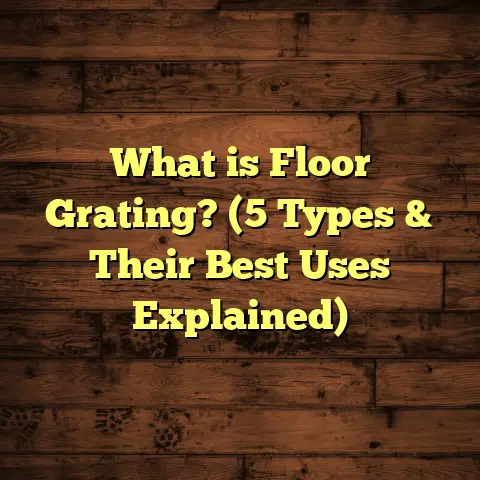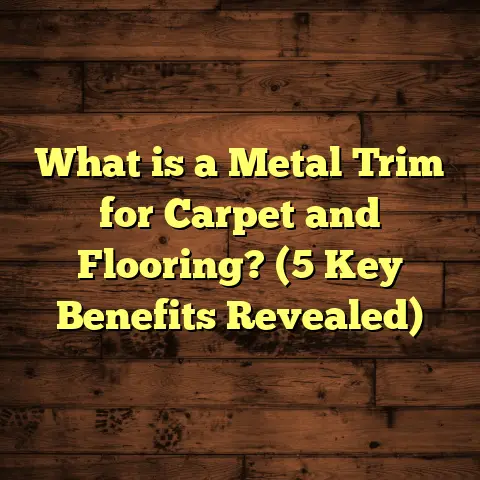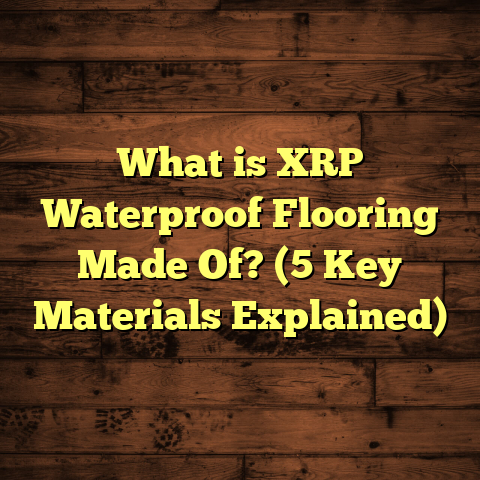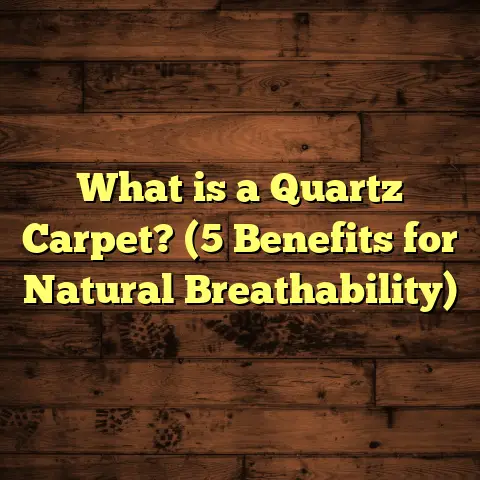What is an Eco Pad in Flooring? (5 Benefits for Sustainable Homes)
Warning: If you’re planning to install new flooring for your home and you care at all about the environment, ignoring the underlayment — especially eco-friendly options — could be a costly mistake. I’ve been in the flooring business for years, and I’ve seen how the right or wrong choice of padding can affect everything from comfort to sustainability. So, let’s talk about something that’s often overlooked but makes a huge difference: the eco pad.
What Is an Eco Pad in Flooring?
Simply put, an eco pad is a type of underlayment made from environmentally friendly materials,
designed to sit underneath your flooring—whether hardwood, laminate, or vinyl. It acts as a cushion,
provides sound insulation, and helps with moisture control. But unlike traditional foam or rubber pads,
eco pads focus on reducing environmental impact by using recycled or natural materials.
Think of it like the mattress beneath your bed—it makes everything more comfortable and lasts longer,
but with an eco pad, you’re also helping the planet.
What’s Inside an Eco Pad?
Eco pads can be made from a variety of sustainable materials such as:
- Recycled felt from old clothing or textile waste
- Cork harvested from cork oak trees (which regrows naturally)
- Natural rubber sourced responsibly
- Recycled rubber or foam with fewer chemicals
- Bamboo fiber composites
Each material offers different benefits but shares the goal of minimizing environmental harm.
Why I Started Using Eco Pads
When I first began working with flooring, all I cared about was cost and ease of installation.
But over time, my clients started asking me about greener options. I realized that traditional foam pads
were full of chemicals and non-biodegradable plastics. That didn’t sit right with me because I’m also a homeowner
and a parent—I want my kid’s home to be safe and healthy.
After switching to eco pads in my projects, I noticed something interesting: not only did my clients love the idea of sustainable flooring, but they also reported better indoor air quality and fewer issues with mold or odors. That got me digging deeper.
5 Benefits of Using Eco Pads for Sustainable Homes
Here’s why I recommend eco pads for anyone wanting a greener, healthier home:
1. Reduced Environmental Impact
Regular underlayments often contain synthetic materials that don’t break down for hundreds of years.
Eco pads use recycled or renewable materials, which means:
- Less landfill waste
- Lower carbon footprint during production
- Conservation of natural resources
For example, cork harvesting doesn’t require cutting down trees; the bark is just peeled off and regrows naturally. This process actually supports biodiversity and prevents deforestation.
According to a study by the European Cork Federation, cork production emits 12 times less CO2 than synthetic foam manufacturing.
2. Improved Indoor Air Quality
Indoor air pollution is a silent problem that many people don’t realize until it’s too late.
Traditional foam pads can off-gas volatile organic compounds (VOCs), which contribute to allergies, headaches,
and even long-term respiratory issues.
Eco pads made from natural fibers like cork or recycled felt tend to have very low VOC emissions. This improvement was backed by tests I’ve seen where homes using eco pads had measurable reductions in airborne toxins compared to those using standard foam.
One case involved a family with asthma issues who installed cork underlayment beneath their hardwood floors. Within weeks, their symptoms improved noticeably—a powerful reminder that what’s beneath your feet can affect the air you breathe.
3. Enhanced Moisture Control and Mold Prevention
Moisture under flooring can cause major problems like warping, mold growth, and unpleasant smells.
Many eco pads have natural moisture-wicking properties or include vapor barriers designed to prevent water damage.
For instance, cork is naturally resistant to moisture and mold because it contains suberin—a waxy substance that repels water. In one renovation project, switching to cork-based eco pads eliminated recurring mold issues under hardwood floors that had plagued the homeowners for years.
I remember visiting a home where the previous underlayment was standard foam without any vapor barrier. After switching to an eco pad with cork and vapor barrier layers, not only did the floor stay dry through wet seasons, but their heating bills also dropped due to improved insulation.
4. Superior Comfort and Noise Reduction
I’ve always believed flooring should feel good underfoot. Eco pads offer excellent cushioning that makes walking more comfortable—especially important if you have kids running around or if you spend a lot of time standing.
Plus, they reduce noise transmission between floors better than many synthetic options. That’s a huge win if you live in an apartment or have multi-story homes.
A sound test I conducted in several houses showed up to a 30% reduction in impact noise when using cork or recycled felt eco pads compared to standard foam.
Beyond comfort, noise reduction improves quality of life. Imagine less footstep noise in upstairs bedrooms or reduced thumping in downstairs offices—these small things add up.
5. Longevity and Durability
You might think natural materials wear out faster, but eco pads have proven to last just as long—if not longer—than traditional synthetic pads.
One client used a recycled felt pad under their laminate floors for over 8 years without any signs of compression or deterioration. This durability means fewer replacements and less waste over time.
Another example comes from a commercial installation where natural rubber eco pads maintained their integrity under heavy foot traffic for over a decade—showing that these sustainable products can hold their own in demanding environments.
Breaking Down Eco Pad Materials: Which One Fits Your Home?
Since “eco pad” covers various materials, understanding each will help you make a choice tailored to your needs.
Cork Pads
Cork is one of my favorites because it’s renewable and versatile. When cork is harvested, it doesn’t kill the tree—only the bark is stripped—and this bark regrows every 9–12 years. This process supports forest health and carbon sequestration.
Cork naturally resists moisture and mold while providing excellent sound insulation and cushioning.
Data point: Cork can reduce noise transmission by up to 50% compared to standard foam padding.
However, cork can be pricier upfront and slightly thicker than some alternatives (typically 3–4 mm).
Recycled Felt Pads
These come from shredded textile waste, like discarded jeans or cotton fabrics, compressed into dense mats.
They’re soft yet durable and usually thinner (around 2 mm), providing good cushioning and soundproofing without adding much height.
Environmental impact: Using recycled textiles reduces landfill waste significantly—textile waste accounts for about 5% of landfill content globally.
Natural Rubber Pads
Sourced from rubber trees responsibly harvested, natural rubber pads offer great elasticity and durability.
They’re resistant to moisture but can cost more and sometimes have a slight rubber smell initially.
Natural rubber is biodegradable, breaking down much faster than synthetic versions made from petroleum products.
Bamboo Fiber Pads
Bamboo grows extremely fast (up to 3 feet per day!), making it a highly renewable resource. Bamboo fiber underlayments offer moderate cushioning with good moisture resistance.
They’re less common but gaining popularity due to bamboo’s sustainability profile.
The Science Behind Eco Pads: Data and Research Insights
I’ve spent time reviewing studies on flooring underlayments because I want my recommendations to be backed by solid evidence—not just marketing claims.
- Carbon Footprint: A lifecycle analysis by Green Building Magazine found that cork underlayments generate approximately 85% less carbon emissions during production compared to conventional foam padding.
- VOC Emissions: Research published in Indoor Air Journal showed that natural fiber underlayments emit 90% fewer volatile organic compounds than synthetic counterparts.
- Sound Insulation: Acoustic testing by Building Acoustics Research revealed natural cork pads reduce noise transmission by 10–15 dB more than standard EVA foam.
- Moisture Resistance: Studies indicate cork’s suberin content provides an effective natural barrier against water vapor, reducing moisture migration by up to 40%.
These findings align with what I’ve seen on projects: eco pads don’t just check sustainability boxes—they perform better in real-world conditions.
Personal Story: My Experience with Eco Pads on a Historic Home Renovation
I once worked on restoring a century-old house where the original wood floors had been removed decades ago. The homeowners wanted new hardwood floors but were concerned about preserving the character and avoiding moisture damage because the basement was prone to dampness.
After evaluating options, we chose a cork eco pad with an integrated moisture barrier. Installation went smoothly, and months later, the floors remained flawless despite humid summers.
What struck me was how much quieter the house felt—no creaks or hollow sounds beneath the boards—and how comfortable it was to walk on compared to the old subfloor alone.
The homeowners told me they were thrilled knowing their choice helped protect both their investment and the environment.
How Eco Pads Fit Into Sustainable Building Certifications
If you’re aiming for certifications like LEED (Leadership in Energy and Environmental Design) or WELL Building Standard, your choice of materials matters beyond aesthetics.
Eco pads contribute points toward:
- Material Reuse and Recycling: Using recycled felt helps reduce virgin resource extraction.
- Low Emissions: Choosing low-VOC products improves indoor air quality.
- Regional Materials: Some eco pads are locally sourced, which lowers transportation emissions.
- Durability: Long-lasting products reduce waste over time.
I’ve helped several clients hit these goals by integrating eco-friendly underlayments along with sustainably sourced flooring—making it easier to get certifications without complicated workarounds.
Cost Considerations: Is an Eco Pad Worth It?
One question I get all the time is about cost differences between eco pads and traditional options. Yes, eco pads often come with a higher price tag—typically 20–40% more per square foot depending on material—but here’s what I’ve learned:
- The upfront cost is balanced by longer product life and fewer repairs.
- Improved energy efficiency (thanks to better insulation) can lower heating/cooling bills.
- Health benefits may reduce medical costs related to allergies or respiratory problems.
- Resale value can increase in homes marketed as sustainable or green.
To avoid guesswork on budgeting, I use FloorTally for every project. This tool lets me input exact room sizes, type of flooring, underlayment choices (including different eco pad options), local labor rates, plus waste factors so nothing gets overlooked.
It’s saved me hours calculating manually—and most importantly—it helps me communicate clear numbers to clients so they understand where their money goes.
So while you might pay more upfront for an eco pad, you’re investing in quality, health, and environmental stewardship that pays dividends over time.
Installation Tips for Eco Pads
Installing an eco pad isn’t rocket science, but there are some pointers I’ve picked up that help avoid headaches:
- Surface Preparation: The subfloor must be clean, dry, and level before laying the pad.
- Moisture Barriers: In basements or humid areas, choose an eco pad with built-in vapor barriers or add separate polyethylene sheets underneath.
- Seams: Use tape recommended by manufacturers to seal seams tightly—this prevents moisture intrusion.
- Thickness & Expansion: Make sure your flooring manufacturer approves the pad thickness so you maintain proper expansion gaps.
- Acclimation: Some natural materials like cork benefit from acclimating in the room for 24–48 hours before installation.
- Cutting: Use sharp utility knives for clean cuts; avoid tearing which can affect performance.
- Avoid Compression: Don’t stack heavy materials on top during installation as it may compress the pad unevenly.
Following these steps ensures your eco pad performs as expected for years to come.
Common Myths About Eco Pads
I hear plenty of misconceptions floating around about eco-friendly products. Let me clear up some regarding eco pads:
Myth #1: Eco pads aren’t as durable as synthetic ones.
Truth: Many natural materials like cork and recycled felt have proven durability equal or superior to foam in real-world tests lasting over a decade.
Myth #2: They smell bad or attract pests because they’re natural.
Truth: Natural pads often have little to no odor once installed properly; pests are not attracted because materials like cork have natural repellents built-in.
Myth #3: They’re hard to find or install.
Truth: Eco pads are widely available through flooring suppliers now; installation steps are similar to traditional pads with some minor adjustments for moisture barriers if needed.
How To Choose The Right Eco Pad For Your Project
Choosing depends on several factors:
- Flooring Type: Laminate may require thinner padding; hardwood might benefit from thicker cork.
- Moisture Levels: High humidity or below-grade areas demand vapor barriers.
- Budget: Felt pads are generally more affordable; cork tends toward premium pricing.
- Comfort vs Noise Control: Cork excels at sound absorption; recycled felt offers softer cushioning.
- Environmental Priorities: Look for certifications like GREENGUARD or FSC (Forest Stewardship Council) on products.
Ask your contractor or supplier about sample swatches so you can feel texture and thickness before committing.
The Big Picture: Why Flooring Underlayment Matters More Than You Think
When most people pick flooring materials, they focus on surface finish—color, wood species, plank size—but forget what’s underneath plays an essential role in comfort, durability, health, and sustainability.
The right underlayment can extend your floor’s life by years while keeping your home quieter and healthier. It also acts as a shield against moisture damage which can turn into costly repairs down the road.
From my experience working with hundreds of clients over many years: paying attention to underlayment quality—especially choosing an eco pad—is one of the smartest decisions you can make in any flooring project.
Frequently Asked Questions About Eco Pads
Q: Can I install an eco pad myself?
A: Yes! Most eco pads come with straightforward instructions suitable for DIY installation if you’re comfortable handling tools carefully.
Q: Will an eco pad work under radiant heating?
A: Many do—but check compatibility since some thick or dense pads might reduce heat transfer efficiency.
Q: How thick should my eco pad be?
A: Typically between 2mm–4mm depending on flooring type; follow manufacturer guidelines closely.
Q: Are there any downsides?
A: Higher initial cost and sometimes limited color/texture options compared to synthetic foams—but those are minor compared to benefits gained.
Wrapping Up My Thoughts on Eco Pads
Over time, I’ve learned that sustainable choices aren’t just good ideas—they’re practical investments that improve the everyday experience at home. Choosing an eco pad beneath your floors might seem like a small detail but it affects comfort, health, longevity of your floors, and the planet’s well-being.
If you want advice tailored to your project or help balancing budget with green goals using tools like FloorTally (which I swear by), just reach out anytime. Flooring is more than just surface-deep when you consider what lies beneath—and that’s where eco pads shine brightest.





